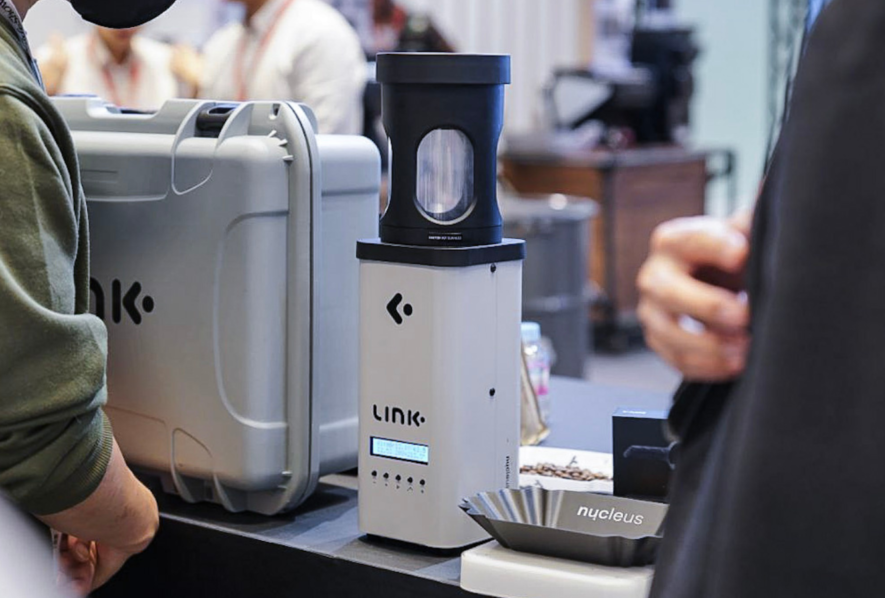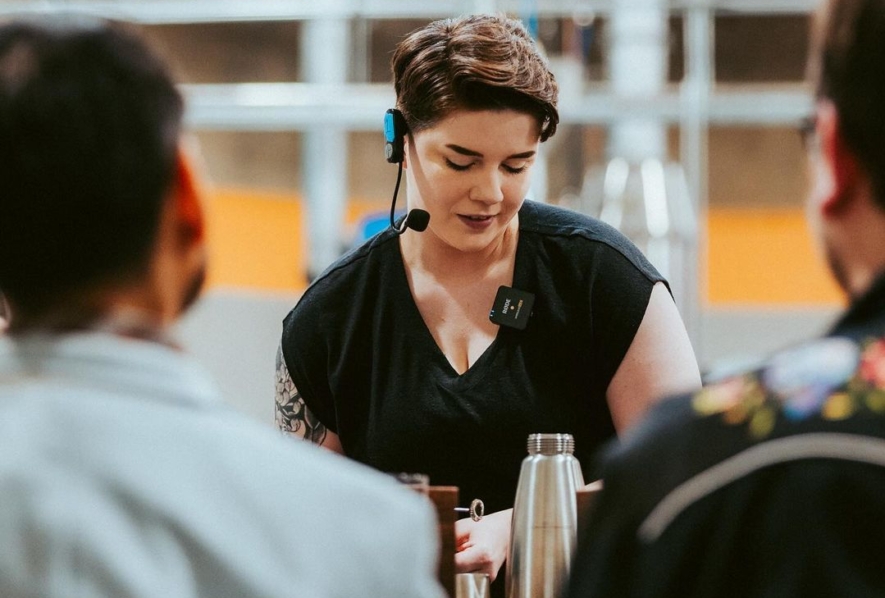:
A new world champion
Following the completion of the 2024 Specialty Coffee Expo (Chicago) and the World Brewers Championship, we spoke to the new World Brewers Cup Champion, Martin Wölfl about his presentation, and how he used small batch roasting to make a championship-winning coffee.
Martin Wölfl is the 2024 World Brewers Cup Champion, following three days of competition between national championships at the Specialty Coffee Expo 2024 in Chicago, USA.
To prepare his coffee for the world stage, Martin worked with the Nucleus Coffee Tools team during several preparation sessions, hosted at the Metropolis Coffee Roasterie in Chicago. During these sessions, a custom roast profile was created with the LINK roaster in order to accentuate the best qualities of Martin’s coffee, taking into account his brewing technique and the ageing of the coffee throughout the duration of the competition.

"[The LINK] is so modern, and it gives you all the feedback about the coffee and what you need out of it."
The coffee
We first met Martin in 2022 in Melbourne, during the first time he was competing on the world stage at the Melbourne International Coffee Expo (MICE) – he approached our booth and we quickly formed a relationship with him, recognising his passion for coffee and his kind, friendly personality.
Since this time, we have worked closely with Martin and his roastery, Wildkaffee Rösterei, as both partners in sharing the LINK roaster across Europe and in competition preparation. In 2023 our Director, Sam Corra visited the team at Lost Origin Coffee Lab in Panama and connected Martin with them, believing that several of the lots they had worked on could potentially perform well on the competition stage.
The coffee Martin selected and took to the World Brewers Cup stage was a Geisha variety, grown at Finca Maya in the Boquete region of Panama. This coffee was processed by Franz Zeimetz of Lost Origin with Natural Anaerboic processing, using two steps – the cherries were first fermented with specialised yeast and secondly, with lacto-bacteria over a period of four days. Finally, the coffee was disinfected and dried at a controlled temperature for 33 days.

The preparation
As part of our Sponsorship Program for the World Coffee Championships, the Nucleus Coffee Tools team offered a number of competitors support for the World Brewers Cup competition, including the sponsorship of equipment, the use of a training space in Chicago, and the loan of LINK roasters.
Prior to the competition, we offered Martin the use of the training space – provided by Metropolis Coffee – and the use of a LINK roaster during his time in Chicago. Martin and his coach, Janine de Laar, booked several sessions with our team at Metropolis and arrived as early as possible to Chicago to collect their LINK and begin preparing.
“The LINK, in my opinion, is a game changer. And as I said already in my speech and the presentation, it’s one of the best innovations we had over the last year,” Martin says.
“It’s solving so many problems for roasters, brewers, green coffee buyers, and for producers. It’s a easy innovation, and one where we can get such incredible results out of it. It’s easy to handle, and the profiles you are recommend from the app tells you a lot. It’s so modern, and it gives you all the feedback about the coffee and what you need out of it.”
During the initial training session at Metropolis Coffee, Martin, Janine and our team experimented with several roasts of the coffee, using small batches in order to determine which profile and approach would provide the best expression of the Geisha from Finca Maya.
“You just need 80 grams or less, and you can have so many different roasts,” Martin says.
“You can quickly see how the coffees are reacting, what kind of profile you need, and you can play around so easy. You can explore a big portfolio of roast profiles where, in my opinion, brewers are able to play around.”

"The acidity was so well integrated in the whole profile, that it was more easier for myself as a brewer to accentuate doing the brewing and with the water and grind size – so it gave me a lot of opportunities."
The roast
In preparing the coffee, our team member Jerome Rosler worked with Martin and Janine to test a number of profiles, and came up with a tailored roast plan that suited his specific brew method.
“As Martin was using the Orea Narrow V4 – with the fast bottom to emphasise the faster extraction – the thing we wanted to emphasise the most was pushing for this sweeter cup profile,” Jerome says.
“That enabled him to have these long sweet tropical notes of honeydew and pineapple from the amazing processing from Lost Origin, while maintaining the beautiful subtle Finca Maya geisha variety florals of rose hip and hibiscus.”
After a lot of tasting and selection, the team decided on a profile that achieved these goals and that would age ideally for the competition. This was executed over a 7-minute profile on the LINK roaster, with a 12% development.
“This customised roast had a ROR of 8 degrees entering into first crack at 210.5-211, pushing that fruit intensity,” says Jerome. “The shorter, 50-second (12%) development enabled us to lock in that silky body and delicate florals.”

When exploring various profiles, Martin and Janine also favoured this approach as it allowed an integration of various aspects of the coffee, including its acidity and an array of fruit flavours. For Martin’s brewing technique, this allowed him to experiment with changing various parameters.
“In these preparations, this profile Jerome developed was a profile aimed to highlight florality, to get cleanness, to get sweetness, and to also like accentuate this tropical flavors, but also red fruits,” he says.
“This was a really nice profile because it was not too light, because otherwise the acidity will pop up too intense – it was a profile we took like to get a really good sum up of everything. The acidity was so well integrated in the whole profile, that it was more easier for myself as a brewer to accentuate doing the brewing and with the water and grind size – so it gave me a lot of opportunities.”

"It’s a really great innovation and I think it can help a lot of brewers out there."
Using the LINK
Unlike most roasters, that have a pre-heating before the coffee enters the roast chamber, each roast with the LINK starts at room temperature. The internal bean temperature matches the ambient roast temperature right from the beginning, resulting in a more even roast, lowers sample CO₂ levels and allows roasters to taste the full potential of their coffee much earlier.
When experimenting with his coffee, Martin and Janine were able to brew and evaluate a number of roasts immediately after roasting, streamlining his selection of the profile that he would ultimately present on stage.
“After each roast we were able to brew the coffee directly – this gave us the chance to adapt the profile immediately and made the roast session very productive,” says Janine.
“Sharing our impressions with each other was really motivating and gave Martin a good feeling to be able to present it on stage. The results from one batch to another is very even, so we didn’t have to worry about any non-uniform results.”
“With the LINK roaster you can brew very soon [after roast] and get really good results,” Martin added. “So imagine, we brewed directly after the roasts and already got a really good feedback, where we are sitting on the profile and we can adjust it very fast – we don’t have to wait two or three weeks.”
Although the coffee performed well directly off roast, this approach in roasting also enabled the coffee to reach a ‘peak’ age for the final days of the competition – meaning that the positive qualities of the coffee improved over time, and were at their best during the finals stage of the World Brewers Cup.
“Fresh off roast, we were in love with the insane tropical fruit expression that made it long and sweet, and after 7 days of age, this expression was truly remarkable with such powerful aromatics and transition of tropicality while having a refined acidity and mouthfeel,” Jerome says.
Even though the coffee from Finca Maya that Martin used was an extremely fresh crop – harvested and processed earlier in 2024 – the custom roast profile enabled him to taste and select his coffees straight off roast, with ease.
“The coffee was peaking after seven days, so it was quite incredible. And we shouldn’t forget that the coffee I used was so fresh after harvest, so I wasn’t sure if we can handle that because the coffee was picked in the second week of January,” Martin says.
“But as we saw with the LINK, with this kind of roaster, we can also handle this kind of challenge. It’s a really great innovation and I think it can help a lot of brewers out there.”
A complete pack of Martin’s roast profiles – styled around the profile used for his championship coffee – will be released with Addis, our upcoming operating system update for the LINK roaster on May 1, 2024.

Competitor stories: Suki Ma
Following the completion of the 2024 Specialty Coffee Expo (Chicago) and the World Brewers Championship, we spoke to the new World Brewers Cup Champion, Martin Wölfl about his presentation, and how he used small batch roasting to make a championship-winning coffee.
Martin Wölfl is the 2024 World Brewers Cup Champion, following three days of competition between national championships at the Specialty Coffee Expo 2024 in Chicago, USA.

LINK announced as official sample roaster of the World Coffee Roasting Championships
Following the completion of the 2024 Specialty Coffee Expo (Chicago) and the World Brewers Championship, we spoke to the new World Brewers Cup Champion, Martin Wölfl about his presentation, and how he used small batch roasting to make a championship-winning coffee.
Martin Wölfl is the 2024 World Brewers Cup Champion, following three days of competition between national championships at the Specialty Coffee Expo 2024 in Chicago, USA.

Competitor stories: Morgan Eckroth
Following the completion of the 2024 Specialty Coffee Expo (Chicago) and the World Brewers Championship, we spoke to the new World Brewers Cup Champion, Martin Wölfl about his presentation, and how he used small batch roasting to make a championship-winning coffee.
Martin Wölfl is the 2024 World Brewers Cup Champion, following three days of competition between national championships at the Specialty Coffee Expo 2024 in Chicago, USA.
